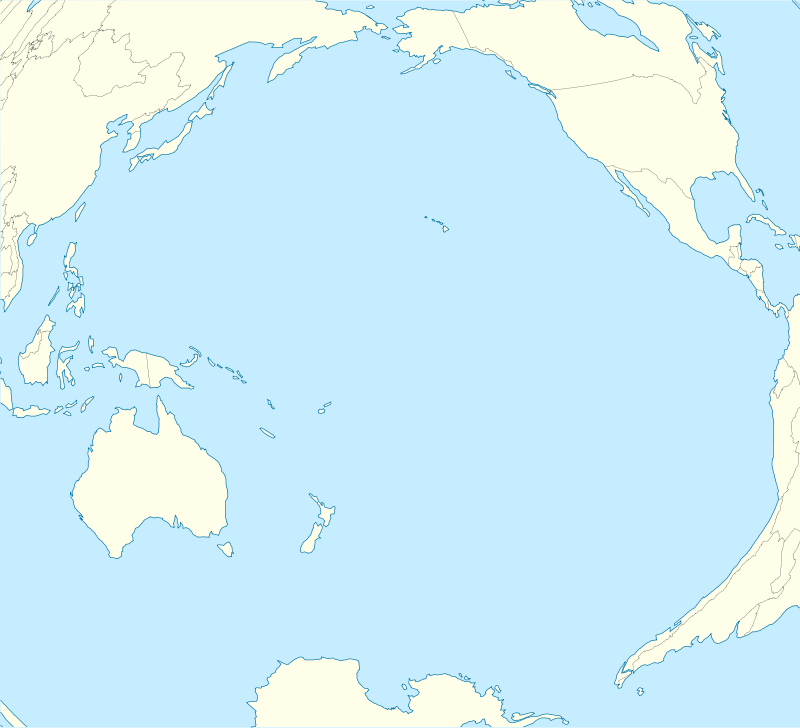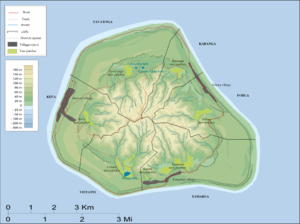Mangaia

| Native name: <span class="nickname" ">A'ua'u | |
|---|---|
|
NASA picture of Mangaia Island | |
 Map of Mangaia Island | |
| Geography | |
| Location | Central-Southern Pacific Ocean |
| Coordinates | 21°55′S 157°57′W / 21.917°S 157.950°W |
| Archipelago | Cook Islands |
| Area | 51.8 km2 (20.0 sq mi) |
| Administration | |
| Demographics | |
| Demonym | Mangaian |
| Population | 744 (2001) |
Mangaia (traditionally known as A'ua'u Enua, which means terraced) is the most southerly of the Cook Islands and the second largest, after Rarotonga.
Geography
Geologists estimate the island is at least 18 million years old, making it the oldest in the Pacific. It rises 4750 m (15,600 ft) above the ocean floor and has a land area of 51.8 km2.[1] It has a central volcanic plateau and, like many of the southern Cook Islands, it is surrounded by a high ring of cliffs of fossil coral 60 m (200 ft) high, known as the makatea. The highest point is Rangi-motia, 169 m above sea level, near the centre of the island. Lake Tiriara is a body of fresh water in the south.
The population of Mangaia comprises about 700 people.[1] The capital is the village of Oneroa, on the west coast, containing about half the population. There are two more villages, Tamarua in the south and Ivirua in the northeast.
Puna and Tapere divisions
After Pangemiro secured the temporal power, the districts and sub-districts were distributed among the Manaune and Ngati-Tane tribes. The distribution on the right (tu'a a katau) was supposed to favor Ngati-Tane, and the distribution on the left (tu'a a kaui) to favor the Manaune.
In actual fact, the Manaune received a greater number of sub-districts than the Ngati-Tane. In the manuscript of Mamae, the following lists of sub-districts with the awards of district and sub-district chiefs were written under the heading, "Te tu'anga ia A'ua'u, i te tara a te aronga pakari"
— The distribution of Mangaia, according to the story of the old people
Traditionally, the Island has been subdivided into six Puna (Districts) headed by a Pava (District Chiefs), which are very nearly sectors meeting at the highest point near the center of the island, Rangi-motia.[2] The districts are, as on some other islands of the Lower Cook Islands, further subdivided into 38 traditional sub-districts called Tapere.[3] In the Cook Islands constitution however, the six districts are listed as Tapere.[4] The Districts clockwise, starting in the south, with their Sub-Districts and Chiefs, are:
| Puna/(Pava) | Tapere | Rangatira | Remarks |
|---|---|---|---|
| 1. TAMARUA/(Parima held the "Pauru-O-Rongo") | |||
| 1.1 Maru-Kore | Maunganui | ||
| 1.2 Poutoa-I-Uta | Kaimoe | ||
| 1.3 Poutoa-I-Miri | Te Ouapuku | ||
| 1.4 Akaea | Teau | ||
| 1.5 Te-Vai-Kao | Pekai | Given by the Manaune to Numangatini Ariki as a present. | |
| 1.6 Angauru (Autaki) | Arakauvae | Afterwards given to Tereavai (Ngati Vara) "Ua tutukuia ia Tereavai" | |
| 1.7 Vaitangi (Pukuotoi) | Tia-Iti | ||
| 1.8 Te-Vai-Taeta-I-Uta | Aitama | ||
| 1.9 Te-Vai-Taeta-I-Tai | Maueue |
Note: The first three Tapere in Tamarua were awarded to Ngati-Tane, and the remaining six to Manaune. The Ngati-Tane gave one and the Manaune gave two to members of other tribes. Parima, the Pava, had no Tapere.
| Puna/(Pava) | Tapere | Rangatira | Remarks |
|---|---|---|---|
| 2. VEITATEI/(Motuanga had the "Spear Wound") | |||
| 2.1 Te-Noki | Motuanga | ||
| 2.2 Te-Tuaroa (Te-Tukono) | Taia-Iti | ||
| 2.3 Te-Tuapoto | Punga-Rua | ||
| 2.4 Te-Tarapiki | Pakuunga | ||
| 2.5 Kaikatu | Ruaporo | ||
| 2.6 Angarino | Arokapiti |
Note: Three sub-districts above went to Ngati-Tane, of which Arokapiti was the leader, and three to Manaune, of which Pangemiro was the leader. Motuanga was Pava and held a sub-district.
| Puna/(Pava) | Tapere | Rangatira | Remarks |
|---|---|---|---|
| 3. KEIA/(Muraa'i had the "Battle Scar") | |||
| 3.1 Akaoro | Muraa'i and Tangataroa | ||
| 3.2 Tapuata | Te-Ika | ||
| 3.3 Tongamarama | Raoa | ||
| 3.4 Te-Inati | Metua-Uti | ||
| 3.5 Rupetau-I-Miri | Okianga | ||
| 3.6 Rupetau-I-Uta | Te-Ao | The deposed High Priest |
Note: Mamae states, "Eia tu'anga e ono nei, tei a Pangemiro te 'aka'aere; kareka o te tutara i runga i'o tei Arokapiti." (These six shares, the distribution was with Pangamiro; but the title above them was with Arokapiti). This seems to mean that Pangemiro appointed the sub-district chiefs, but Arokapiti selected the District Chief.
| Puna/(Pava) | Tapere | Rangatira | Remarks |
|---|---|---|---|
| 4. TAVAENGA/(Are-Rua had the "Spear Wound") | |||
| 4.1 Te-Pueu | Are-Rua | ||
| 4.2 Te-Mati-O-Pa'eru | Te-Kako | ||
| 4.3 Au-Ruia | Numangatini | ||
| 4.4 Maro | Karomatangi | ||
| 4.5 Te-Rupe | Vai'are | ||
| 4.6 Ta'iti | Vaipo |
Note: The six sub-districts above were shared equally between Ngati-Tane and the Manaune. In a list given by the District Chiefs of Veitatei, Keia, and Tavaenga, only Ta'iti and Maro coincide with the above, and Te-Ivi-O-Ru, Rangatira, Te-Tua-Roa, and Tiroango are given as the names of the other four sub-districts.
| Puna/(Pava) | Tapere | Rangatira | Remarks |
|---|---|---|---|
| 5. KARANGA/(Pangemiro had the "Spear Wound") | |||
| 5.1 Kaau-I-Uta | Pangemiro | ||
| 5.2 Kaau-I-Miri | Mauri | ||
| 5.3 Teia-Pini | Pangemiro | ||
| 5.4 Teia-Poto | Are-Tupe | ||
| 5.5 Teia-Roa | Makaatu |
Note: In another manuscript the word Teia in the third, fourth, and fifth sub-districts is spelled Te-i'i-a and is followed by the same endings. Pangemiro, the Temporal Lord, lived in Karanga, and all the sub-districts went to the Manaune. Though there are only five Tapere, the Manaune say there are six with the wood (e ono i te rakau). The story is that Vairoto, who belonged to Karanga, was indicated as a human sacrifice to Rongo. It was evidently left to the Manaune to bring the sacrifice to the marae in Keia. Thereupon Tuarau and Tumutoa of Ivirua carved a figure to represent Vairoto, and Pangemiro sent it in to the marae. The Manaune were strong enough to carry off this disobedience to the high priest, and they commemorated the event by making a wooden effigy of Vairoto a metaphorical sixth Tapere.
| Puna/(Pava) | Tapere | Rangatira | Remarks |
|---|---|---|---|
| 6. IVIRUA | |||
| 6.1 Te-Pauru-O-Rongo | Mauri | ||
| 6.2 Te-Korokoro | Takitaki | ||
| 6.3 Te-Uturei | Nia (Tuarau) | ||
| 6.4 Te-Ara-Nui-O-Toi | Tane | ||
| 6.5 Te-I'I-Maru | Tuamoru'ia (Tumutoa) | ||
| 6.6 Avarari | ? |
Note: Mamae gave no details and omitted the sixth sub-district of Avarari. Local informants stated that Te-Pauru-O-Rongo went to the Ngariki tribe, the Ara-nui-o-Toi went to Ngati-Tane, and the remaining four sub-districts went to the Manaune. As Mauri, the sub-district chief of Te-Pauru-O-Rongo, was a son of Pangemiro, it would appear that, though he ruled over the sub-district, the land was for division among the Ngariki tribe. Tuarau and Vairota of the Karanga District and the two sub-districts of Te-uturei and Te-i'i-maru, to which these men belonged, are coupled together under the name of Nga-Toki (the adzes) to commemorate the use they made of their adzes.
Economy

Mangaia is renowned for its shell neckbands or "eis". These are made from the shells of the tiny yellow snail, the pupu, which emerges only after rain. Gathering, piercing and stringing is a very time consuming business. The women of the island often give the highly prized strands away as gifts of friendship to visitors from other islands in the group.
Mangaia is also renowned for its coconuts. The people of the island have long considered them a staple plant of survival. They remain an important crop even today, providing food, coconut milk, and also fiber.
History
Before settlement by missionaries, Mangaia was ruled by fierce warriors in a constant struggle over land and crops. The first recorded European to arrive at Mangaia was Captain James Cook in 1777. Long ago, during a trip to London, Numangatini, or "King" John of Mangaia, received from Queen Victoria herself a Union Jack. The flag still exists, albeit in two pieces; half is supposed to be in Oneroa, and the other half in Tonga.[5]
Birds described from subfossil remains that became extinct as a consequence of human settlement of the island and the introduction of exotic mammals include the Mangaia rail (Gallirallus ripleyi) and the Mangaia crake (Porzana rua).[6]
See also
References
- 1 2 Parkes (2006).
- ↑ District and Subdistrict Chiefs | NZETC
- ↑ Districts and Subdistricts | NZETC
- ↑ Constitution of the Cook Islands
- ↑ Mangaia, Oldest island in the Pacific: British and proud of it
- ↑ Steadman, D. W. (1986). "Two new species of rails (Aves: Rallidae) from Mangaia, Southern Cook Islands.". Pacific Science. 40 (1): 27–43.
- History (in German)
- Parkes, John (2006-09-00). Protection of Tanga'eo, the endemic Mangaia kingfisher (Todiramphus rufficollaris) from common myna (Acridotheres tristis) (PDF). Contract Report: LC0506/184. New Zealand: Landcare Research. Check date values in:
|date=(help)
External links
- Noncommercial guide and photos of the island
- Mangaia - Garden of the Cook Islands
- Pride in Uniqueness of Our Island Home
- Kaipuleohone includes a collection of written materials that include Mangaia
Coordinates: 21°55′17″S 157°55′23″W / 21.92139°S 157.92306°W